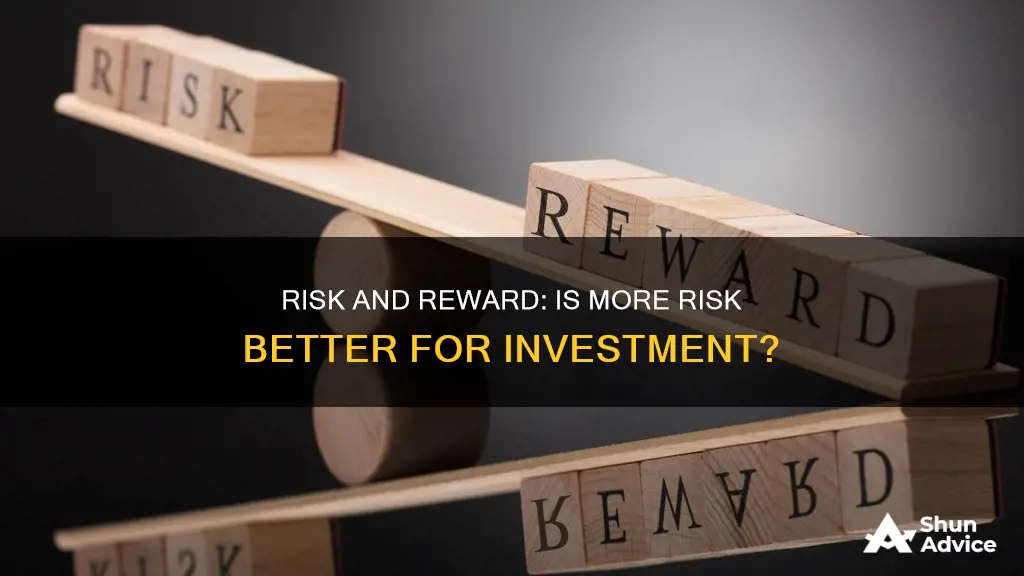
Risk and reward are closely linked in the world of investing. While all investments carry some degree of risk, the potential for gain or loss varies across different types of investments. Generally, the higher the risk, the higher the potential return. This risk-reward trade-off is a key concept for investors to understand when making investment decisions. By investing in riskier assets, such as stocks, investors take on more uncertainty but also have the opportunity for greater financial gains. On the other hand, lower-risk investments, such as government bonds or high-yield savings accounts, offer more stable but typically lower returns.
Determining the appropriate level of risk for an investment portfolio depends on several factors, including an individual's risk tolerance, time horizon, and financial situation. Risk tolerance refers to how much risk an investor is comfortable with and able to take on, while the time horizon considers the amount of time available to invest and reach financial goals. Understanding these factors can help investors make informed decisions about the types of investments to include in their portfolio, balancing risk and reward to meet their financial objectives.
| Characteristics | Values |
|---|---|
| Risk-reward | The higher the risk, the higher the possible return |
| Risk tolerance | Depends on an individual's financial situation, comfort level, and goals |
| Risk capacity | Depends on how much an individual can afford to invest and the returns they need to generate |
| Time horizon | The longer the time horizon, the more risk an individual can afford to take |
| Bankroll | The more money an individual has, the more risk they can take |
| Liquidity risk | Difficulty in cashing out of an investment |
| Concentration risk | The more investments an individual holds, the less risk they take |
| Market risk | Risk of investment value rising or falling due to market conditions |
| Business risk | Risk of corporate decisions affecting the value of investments |
| Political risk | Risk of events in the country of investment affecting the investment |
| Currency risk | Risk of events in the country of investment affecting the currency value |
What You'll Learn
- Risk and return are linked: the higher the risk, the higher the potential return
- Diversification can help manage investment risk
- Time horizons: longer investment periods can allow for higher-risk investments
- Risk tolerance: how much risk an individual is willing to take on
- Risk capacity: how much risk an individual is able to take on

Risk and return are linked: the higher the risk, the higher the potential return
When it comes to investing, risk and return are closely linked. While all investments carry some degree of risk, the potential for higher returns typically increases alongside the level of risk. This relationship is based on the idea that investors who take on riskier investments and the possibility of losing money should be compensated for their risk.
The higher the risk, the higher the potential return. This concept, known as risk-reward, is a general trade-off underlying most investments. When you invest money, there is always a risk, large or small, of losing your money or not getting it back; the investment may fail. By taking on this risk, you expect a return that compensates for potential losses. In other words, the higher the risk, the more you should receive for holding the investment, and vice versa.
Determining the appropriate level of risk for an investment portfolio can be challenging. One key factor to consider is your risk tolerance, or how much risk you are willing to accept. This involves evaluating your financial situation, including your investment timeline, income needs, and the amount of money you can afford to lose. For example, if you have a longer time horizon, you may be more tolerant of higher risks as you have more time to recoup any potential losses. Additionally, a larger bankroll can provide more flexibility to take on riskier investments.
The investment risk pyramid is a useful framework for allocating assets based on risk and return. At the bottom of the pyramid are low-risk assets like cash and treasuries, while the top consists of smaller allocations to riskier assets like growth stocks. The middle of the pyramid includes moderately risky assets such as corporate bonds and blue-chip stocks. This structure aims to balance risk and reward based on an individual's time horizon, assets, and risk tolerance.
While there is no guarantee of returns in investing, understanding the relationship between risk and return can help investors make more informed decisions about their portfolios. By evaluating their risk tolerance and considering the potential trade-offs between risk and return, investors can strive to maximize their returns while managing their risk exposure.
The Key Factors That Make Deals Investable
You may want to see also

Diversification can help manage investment risk
Diversification is a fundamental aspect of risk management and is critical when building an investment portfolio. It is a strategy that ensures a mix of various investments within a portfolio, reducing market volatility and preventing investors from concentrating all their investments in one area.
Diversification is about creating variety in your investments to reduce risk. It is more than just purchasing a random bundle of investments. The US Securities and Exchange Commission recommends diversifying by asset category and within the asset category. The three main asset classes are stocks, bonds, and cash. Separating investments into these categories helps manage market risk and cushions against market volatility. Once you've separated your investments, you can diversify within each category, for example, by purchasing multiple stocks from several different companies.
Diversification can also be achieved by investing in different industries. Investing in multiple industries dilutes the risk caused by trends or events in any particular industry. This ensures that your investments are not all affected by the same industry-specific risks.
Additionally, investors can make investments of various sizes and types, such as debt, equity, or other assets. This provides a diverse investment portfolio that can complement their current portfolio or accommodate a business's fundraising goals.
As you approach retirement age, managing your investment risk becomes increasingly important. Your risk tolerance and investment style will influence how you diversify your portfolio. For example, younger people may want more risk exposure, while those closer to retirement may want to be more cautious.
While diversification is a powerful tool for managing investment risk, it is essential to remember that it does not guarantee against losses. Market conditions can still cause investments to lose value, even when diversified. However, diversification can help manage the overall risk and smoothen the investment journey.
Mortgage Payoff or Investing: Where Should Your Money Go?
You may want to see also

Time horizons: longer investment periods can allow for higher-risk investments
When it comes to investing, time horizons refer to the length of time an investor expects to hold onto an investment before needing to access their funds. This could be a specific time frame, or a generalised one, such as short-term, medium-term, or long-term.
Longer investment periods, or long-term horizons, are typically associated with goals such as saving for retirement. With a longer time horizon, investors can afford to take more substantial risks, as they have more time to recover from any market downturns. This means they can opt for more aggressive portfolios with a higher allocation of stocks. Over time, the compounding effect of longer investment periods can generate greater profits.
For example, let's consider a couple who are saving for a down payment on a house. This is a short-term investment horizon, so they will probably want to choose a conservative investment option, such as a money market fund, to avoid any sharp swings in the stock market. On the other hand, if these same investors are also saving for retirement, they have a long-term time horizon. Given the length of time until their retirement, they can afford to be aggressive in their asset allocation, choosing upwards of 90% stocks. The long investment horizon will give their portfolio time to recover from any short-term downturns.
It's important to note that while longer time horizons can provide the advantage of higher returns, they also come with certain risks. Longer horizons can expose investors to market volatility and potential losses during downturns. Additionally, funds may be tied up for longer, which could be an issue if emergency funds are needed. Therefore, it is essential to carefully consider your financial goals, risk tolerance, and time horizon before making any investment decisions.
Strategic High-Risk Investment: Maximizing a $30K Portfolio
You may want to see also

Risk tolerance: how much risk an individual is willing to take on
Risk tolerance is a key concept in investing. It refers to the degree of risk that an investor is willing to accept, given the volatility in the value of an investment. Risk tolerance often determines the type and amount of investments that an individual chooses.
An investor's risk tolerance is influenced by factors such as age, investment goals, and income. For example, an aggressive investor commonly has a higher risk tolerance and is willing to risk more money for the possibility of better, yet unknown, returns. On the other hand, a conservative investor commonly has a lower risk tolerance and seeks investments with guaranteed returns.
It's important to note that risk tolerance can change depending on an individual's goals and financial circumstances. Therefore, it is crucial to regularly review your asset allocation, risk willingness, and financial ability for each of your goals.
While some individuals may have a higher risk tolerance and be comfortable with investing in stocks and riskier fixed-income investments such as high-yield bonds, others may prefer lower-risk investments such as high-quality corporate bonds, Treasurys, and bank certificates of deposit (CDs).
Understanding your risk tolerance is crucial in making informed investment decisions. It helps you balance the trade-off between risk and return and ensure that you are comfortable with the level of risk you are taking. By considering both your willingness and financial ability to take risks, you can make investment choices that align with your financial goals and risk tolerance.
Shark Tank India: Investing in India's Future
You may want to see also

Risk capacity: how much risk an individual is able to take on
Risk capacity is an important concept for investors to understand, as it helps them determine how much risk they can take on without jeopardising their financial stability. It is a more objective measure of risk compared to risk tolerance, which refers to an individual's psychological willingness to take on risk.
Risk capacity is influenced by several factors, including:
- Time horizon: The amount of time an individual has to invest plays a crucial role in determining their risk capacity. Generally, a longer investment horizon allows for higher risk-taking, as there is more time to recover from potential losses.
- Income and financial obligations: An individual's income, expenses, and financial commitments, such as dependents or debt, can impact their risk capacity. Those with higher expenses and less disposable income may have a lower risk capacity, as their money may be needed for other priorities.
- Investment portfolio size: The size of an individual's investment portfolio relative to future additions and withdrawals can affect their risk capacity. A larger portfolio can provide more flexibility to take on risk.
- Outside income: A steady and reliable source of income outside of investments can increase risk capacity, as it provides a buffer against potential investment losses.
It is important to note that risk capacity is not static and can change over time due to factors such as age, life events, and economic conditions. Therefore, individuals should regularly assess their risk capacity and adjust their investment strategies accordingly.
While risk capacity focuses on the financial ability to endure potential losses, risk tolerance considers the emotional and psychological comfort with risk. Both factors are crucial in crafting a balanced and effective investment strategy. Achieving harmony between risk tolerance and capacity is key for financial peace of mind and a less stressful investment journey.
Credit Union Investment Strategies: Private Equity Opportunities
You may want to see also
Frequently asked questions
Risk and return are closely linked. The higher the risk, the higher the potential return, and vice versa. For example, stocks have historically provided higher returns than bonds and cash investments, but they are also riskier.
Your risk tolerance depends on your comfort level with risk and your current financial situation. Consider your time horizon (how long you plan to invest for) and your bankroll (how much money you can afford to lose). If you have a short time horizon and a limited bankroll, you may want to choose less risky investments.
While it's impossible to eliminate investment risk, you can manage it through strategies such as asset allocation and diversification. Diversification means putting your money into a range of investments to reduce the impact of any one investment performing badly.







